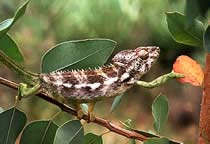Chameleons walk on water

True colours: chameleons probably originated in Madagascar <br>© SPL <br>
Reptile history reveals daring escape from Madagascar
Land-lubber chameleons navigated the oceans to spread around the world. Stowed away on tree rafts, the animals were ferried to distant shores, new research suggests1.
Chameleons aren’t good swimmers: their mitten-like feet are made to grasp twigs and trees. Yet the intrepid animals charted the seas several times in the past 26 million years, say Chris Raxworthy of the American Museum of Natural History in New York, and his colleagues.
The team built up a chameleon chronicle by comparing the anatomy and genetics of 52 species worldwide. The creatures originated on the island of Madagascar off southern Africa, they found, and probably spread out of Madagascar in several waves.
“It’s pretty bold,” says Olivier Rieppel, who studies reptile evolution at the Field Museum in Chicago, Illinois, because it seems counter-intuitive. “It’s hard to imagine an animal swimming more awkwardly,” he says.
The lizards’ most likely escape route was an upturned tree, says Rieppel, or chunks of land chewed off by waves. There are also suggestions that a land bridge once linked Madagascar and mainland Africa – in which case the reptiles might have strolled across.
Land or sea
Raxworthy’s idea counters previous accounts of chameleon history: that they originated on the ancient supercontinent Gondwana and were divided when the land mass split.
India and Madagascar together broke away from Africa 165 million years ago; Madagascar and the Seychelles subsequently separated from India. These events occurred long before chameleons first appeared on the planet – 26 million years ago, according to fossil records.
Many other animal and plant species are thought to have evolved when the movement of continental plates created barriers such as seas and mountains. Divided by water or crag, populations are thought to have evolved into new, related species.
This type of hypothesis can be tested by marrying evolutionary trees with geological records
Dispersal hypotheses such as Raxworthy’s are more difficult to check: “There’s a lot more speculation,” says Mark Springer at the University of California in Riverside.
Springer recently showed that the earliest split of the placental mammals into two basic groups coincides with the separation of South America and Africa around 100 million years ago2. Researchers accept that continental movements and ocean navigation play a role in species dispersal. “They’re both very important,” says Springer.
References
- Raxworthy, C. J., Forstner, M. R. J. & Nussbaum, R. A. Chameleon radiation by oceanic dispersal. Nature, 415, 784 – 787, (2002).
- Murphy, W. J., et al. Resolution of the early placental mammal radiation using Bayesian phylogenetics. Science, 294, 2348 – 2351, (2001).
Media Contact
All latest news from the category: Life Sciences and Chemistry
Articles and reports from the Life Sciences and chemistry area deal with applied and basic research into modern biology, chemistry and human medicine.
Valuable information can be found on a range of life sciences fields including bacteriology, biochemistry, bionics, bioinformatics, biophysics, biotechnology, genetics, geobotany, human biology, marine biology, microbiology, molecular biology, cellular biology, zoology, bioinorganic chemistry, microchemistry and environmental chemistry.
Newest articles

NASA: Mystery of life’s handedness deepens
The mystery of why life uses molecules with specific orientations has deepened with a NASA-funded discovery that RNA — a key molecule thought to have potentially held the instructions for…

What are the effects of historic lithium mining on water quality?
Study reveals low levels of common contaminants but high levels of other elements in waters associated with an abandoned lithium mine. Lithium ore and mining waste from a historic lithium…

Quantum-inspired design boosts efficiency of heat-to-electricity conversion
Rice engineers take unconventional route to improving thermophotovoltaic systems. Researchers at Rice University have found a new way to improve a key element of thermophotovoltaic (TPV) systems, which convert heat…



